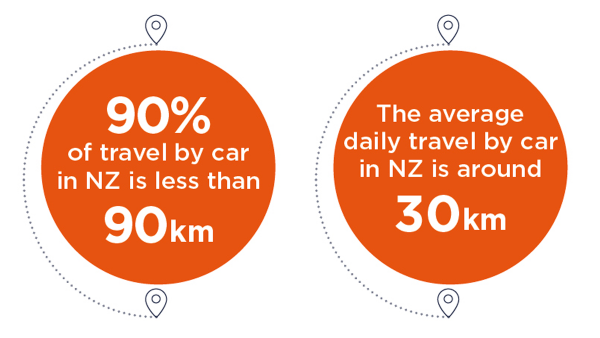Range
Open all sections
Close all sections
– Measuring energy consumption
We use kilowatt-hours (kWh) rather than litres to measure electricity, so you’re unlikely to talk
to EV drivers about dollars per litre, and instead hear them discuss:

cents per kWh, the cost of electricity; determines the cost of travelling and charging

km per kWh, similar to ‘miles per gallon’, or how far you’re driving for a unit of electricity

kWh as a size of battery, which gives you an idea of how far you can drive (range)

kW as a speed of charging, and, also, speed of draining your battery
(A 30kWh battery should take around 10 hours to recharge with a 3kW charger.
Driving at 15kW will drain a 30kWh battery in two hours.)
Depending on driving style and car, you can usually expect to travel around 5 to 7 km per kWh.
A detailed Norwegian study showed almost all cars are charged daily or weekly at home,
and that most cars use a public fast charger once a month or less, which is likely consistent
with New Zealand.
The regular 230 volt AC electricity in our homes, and the regular socket we
use for all household appliances is all you need to recharge your car, though
dedicated equipment is faster and safer. The electrical safety regulator,
WorkSafe, has guidelines on its website about what is required and
recommended for domestic and public electric vehicle charging equipment,
sockets and wiring.
– How far can you drive?
– In a nutshell
It takes less than $25 to fill up even the largest EV battery, depending on your electricity provider.
How far could a petrol or diesel car drive on $25 of fuel?
The Tesla Model S has a max range of 600km, while the much cheaper Mitsubishi i-MiEV
has a max range of 150km.
Statistically speaking, an electric vehicle can easily meet most people’s daily driving needs.

The exact distance you can drive on a single charge depends on the type of EV,
its battery capacity, the type of roads (flat, hilly or winding) and your driving style.
If you’re driving beyond your EV’s battery capacity in one go, or on routes that you
have never travelled before, consider planning a route with a public charging station
at regular intervals.
Power Trip’s trip planning features will help you do this, by take the terrain, elevation
and charging options into account with each trip plan.
– The EPA range
The EPA (US Environmental Protection Agency – National Vehicle and Fuel Emissions Laboratory)
maintains a database of consistent estimates of how far each new EV will
travel on a typical journey, mixing highway and suburban driving.
Check the “EPA Range” if you would like to know more.
The EPA range is a “good guess” and not a guarantee. Different circumstances,
terrain and driving styles will make any car’s range vary significantly.
– Temperature
Temperature can affect the battery.
An EV battery is less efficient in extremes of hot and cold.
In NZ, extreme heat is not (yet!) such a problem, but a 5 to 10% decrease in range
may occur during winter.
– Other power usage
Using in-car features such as air-conditioning, heating or lights and wipers,
will also use power and reduce your range slightly.
– Why does my dashboard range change so much?
All EVs have a dashboard range indicator (sometimes called the Guess-o-meter, or GoM)
that provides a rough guide to the remaining kilometers of travel before the battery runs out.
The GoM indicator is usually based on your last few minutes of driving, and does not
consider upcoming terrain.
Changes in speed, road slope or weather can cause alarming decreases in the remaining
range shown on the GoM.
Your battery has not lost energy, it is just using more of it at that point in time.
Planning tools like Power Trip take the terrain into account to estimate your driving
range and plan your trips accordingly.
Hills
Driving up hills uses more energy than driving along a flat road, and most EVs
regenerate some of the energy driving downhill with regenerative braking systems.
Driving speed
Travelling at higher speeds will drain an EV battery faster, reducing the distance
it can cover between charges.
Corners, bends and intersections
Roads with lots of tight corners and bends will also use more energy. Smooth
acceleration and braking can help to conserve energy and extend an EV’s driving range.
Weather
Strong wind can affect an EV’s driving range. A tailwind can increase driving range,
while a headwind can decrease it.
Wet roads, gravel roads and rural roads can reduce an EV’s driving range.
Tyre pressure
Under- or overinflated tyres can affect an EV’s driving range. Making sure
tyres are fully inflated to the recommended level will increase the range
an EV can achieve on a single charge.
Wheel alignment
Misaligned wheels can reduce an EV’s driving range by a small amount.
Flip the fleet has published detailed information on how tyre pressure
and wheel alignment
can affect EV driving range
Extra weight
Adding extra weight, such as cargo or passengers can decrease an EV’s driving range.
This is important to be aware of when towing a trailer or carrying a lot of extra weight.
Roof racks
External attachments like bike racks or roof racks can reduce an EVs driving range,
as the EV will not be as aerodynamic.